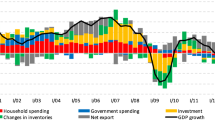Abstract
An intertemporal optimizing model of a small open economy is used to analyze how terms of trade changes affect real exchange rates and the trade balance. Temporary current, (expected) future, and permanent changes in the terms of trade are considered. The results suggest that the relationship between the terms of trade and the current account (the so-called Harberger-Laursen-Metzler effect) is sensitive to whether the model incorporates nontradable goods. Thus, the real exchange rate may be an important variable through which terms of trade shocks are transmitted to the current account.
Similar content being viewed by others
Rights and permissions
About this article
Cite this article
Ostry, J. The Balance of Trade, Terms of Trade, and Real Exchange Rate: An Intertemporal Optimizing Framework. IMF Econ Rev 35, 541–573 (1988). https://doi.org/10.2307/3867110
Published:
Issue Date:
DOI: https://doi.org/10.2307/3867110




